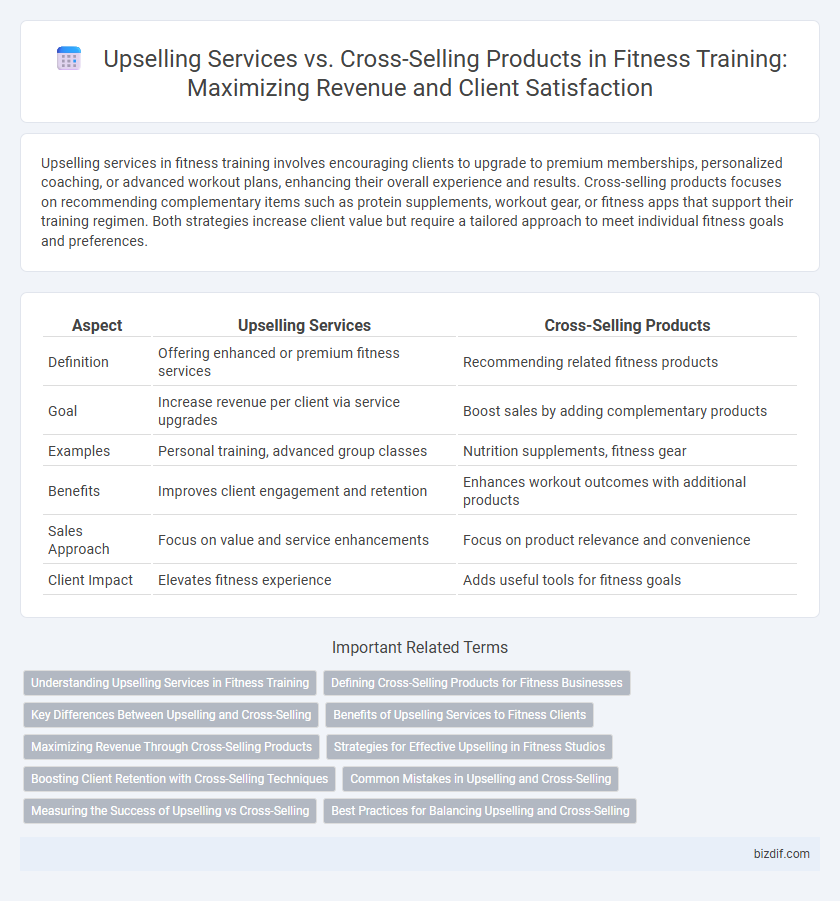Upselling services in fitness training involves encouraging clients to upgrade to premium memberships, personalized coaching, or advanced workout plans, enhancing their overall experience and results. Cross-selling products focuses on recommending complementary items such as protein supplements, workout gear, or fitness apps that support their training regimen. Both strategies increase client value but require a tailored approach to meet individual fitness goals and preferences.
Table of Comparison
| Aspect | Upselling Services | Cross-Selling Products |
|---|---|---|
| Definition | Offering enhanced or premium fitness services | Recommending related fitness products |
| Goal | Increase revenue per client via service upgrades | Boost sales by adding complementary products |
| Examples | Personal training, advanced group classes | Nutrition supplements, fitness gear |
| Benefits | Improves client engagement and retention | Enhances workout outcomes with additional products |
| Sales Approach | Focus on value and service enhancements | Focus on product relevance and convenience |
| Client Impact | Elevates fitness experience | Adds useful tools for fitness goals |
Understanding Upselling Services in Fitness Training
Upselling services in fitness training involves offering enhanced or premium options such as personalized coaching, advanced workout plans, or nutrition counseling to clients already engaged in basic programs. This strategy increases client value and retention by addressing specific fitness goals with tailored solutions. Understanding client needs and demonstrating the benefits of upgraded services are critical for effective upselling in the fitness industry.
Defining Cross-Selling Products for Fitness Businesses
Cross-selling products in fitness businesses involves offering complementary items such as protein supplements, workout gear, or fitness trackers alongside training sessions. This strategy enhances the customer experience by addressing multiple fitness needs, increasing overall sales and client engagement. Effective cross-selling improves retention by providing a comprehensive approach to health and wellness beyond exercise alone.
Key Differences Between Upselling and Cross-Selling
Upselling in fitness training involves encouraging clients to purchase a higher-tier membership, personal training sessions, or premium classes to enhance their workout experience. Cross-selling focuses on recommending complementary products such as nutritional supplements, workout gear, or fitness accessories alongside training packages. Key differences include upselling primarily increasing the value of the core service, while cross-selling aims to boost overall revenue through related product sales.
Benefits of Upselling Services to Fitness Clients
Upselling services in fitness training enhances client results by offering personalized coaching, advanced workout plans, and nutrition guidance tailored to individual goals. These premium services boost client motivation and engagement, leading to improved performance and faster progress. Investing in service upgrades increases client satisfaction and loyalty, ultimately driving higher revenue for fitness professionals.
Maximizing Revenue Through Cross-Selling Products
Maximizing revenue through cross-selling products in fitness training involves offering complementary items like nutrition supplements, workout gear, and recovery tools alongside core services. Personalized recommendations based on clients' training goals increase the likelihood of purchase and enhance customer satisfaction. This strategy not only boosts average transaction value but also reinforces client loyalty by addressing holistic fitness needs.
Strategies for Effective Upselling in Fitness Studios
Effective upselling strategies in fitness studios include personalized training package upgrades based on client progress data and goal-specific program enhancements that increase workout efficiency. Offering premium services like one-on-one coaching, nutrition counseling, or advanced recovery sessions elevates the perceived value while aligning with members' fitness aspirations. Leveraging client management systems to track achievements and suggest tailored upgrades maximizes engagement and revenue growth.
Boosting Client Retention with Cross-Selling Techniques
Cross-selling fitness products such as supplements, workout gear, or personalized nutrition plans enhances client retention by providing added value tailored to individual goals. Integrating cross-selling strategies into training sessions encourages consistent engagement and fosters loyalty through comprehensive support beyond core services. Data shows clients who purchase complementary products demonstrate higher satisfaction and longer membership durations compared to those receiving only upsold services.
Common Mistakes in Upselling and Cross-Selling
Common mistakes in upselling services and cross-selling products in fitness training include offering irrelevant or unnecessary add-ons that do not align with the client's goals, leading to decreased trust and satisfaction. Overloading clients with excessive options during a training session can overwhelm them, reducing the likelihood of purchase and harming the overall client experience. Neglecting to tailor recommendations based on individual fitness levels and preferences results in missed opportunities for effective upselling and cross-selling.
Measuring the Success of Upselling vs Cross-Selling
Measuring the success of upselling versus cross-selling in fitness training involves tracking key performance indicators such as increased revenue per client, client retention rates, and average transaction values. Upselling success is often evaluated by the percentage of clients upgrading to higher-tier training packages or extended memberships, while cross-selling effectiveness is gauged by the sale of complementary fitness products like supplements, apparel, or equipment. Analyzing customer feedback and purchase patterns provides valuable insights into which strategy drives higher client satisfaction and long-term engagement.
Best Practices for Balancing Upselling and Cross-Selling
Balancing upselling and cross-selling in fitness training requires personalized client assessments to tailor service packages that enhance workout results while introducing complementary products such as supplements or apparel. Emphasizing the benefits of each option, trainers should communicate how upgraded services improve fitness outcomes and how additional products support overall health goals. Tracking client preferences and progress enables adaptive recommendations, ensuring a seamless integration of services and products that maximizes client satisfaction and revenue growth.
Upselling Services vs Cross-Selling Products Infographic

 bizdif.com
bizdif.com